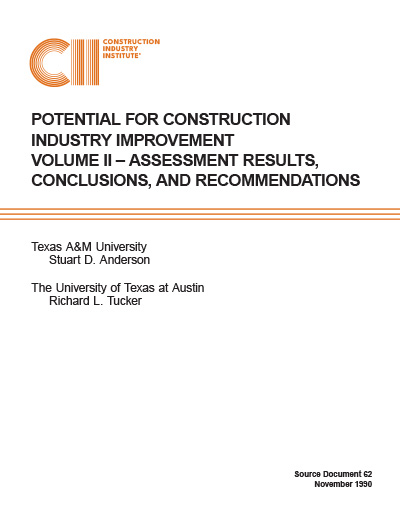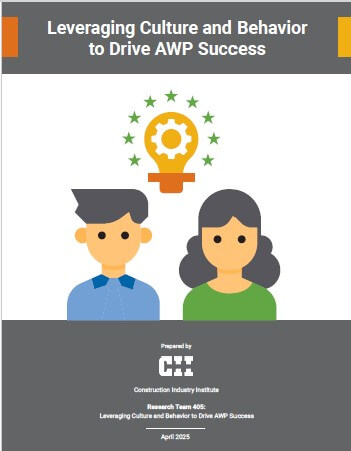
Potential for Construction Industry Improvement, Volume I - Assessment Methodology
The mission of the Construction Industry Institute (CII) is to improve construction cost effectiveness. Through its research the industry has been exposed to key management principles and concepts which could have a great influence (in achieving successful project performance. CII research has also confirmed many recommendations suggested in The Business Roundtable’s Construction Industry Cost Effectiveness (CICE) Study.
These two volumes discuss an attempt to quantitatively measure the current level of utilization on projects of key principles and recommendations endorsed by CII/CICE. Current project performance is also evaluated. Key project characteristics influencing both utilization and performance are explored.
The results reflect the perceptions of respondents from various owner, architect/engineer, and contractor companies involved in the design and construction of facilities. The database for the study consists of 1902 respondents representing 428 owner, A/E, and contractor companies. Each respondent completed an in-depth questionnaire reflecting their on recent projects. The questionnaires were tailored to capture the unique perspective of each participant group Data was collected during the last half of 1988.
Responses indicate that the average level of perceived utilization on projects of CII/CICE principles and recommended practices is about 66% to 70%. About two-thirds of all projects meet or perform better than cost or schedule targets. Eighty percent achieve the technical/quality performance required. Approximately two thirds to three quarters of the A/E and contractor project respectively meet project profit objectives.
An analysis of both respondent and non-respondent data characteristics suggest a bias in favor of the industry’s best and most knowledgeable companies. Therefore, current utilization and performance levels presented may be better than for the industry as a whole.
Other major findings of the study are:
- Higher levels of utilization improve project performance.
- Higher levels of utilization increase project profits for A/Es and construction contractors.
- Maximum utilization could save up to $15 billion annually in project cost.
- Level of utilization is strongly determined by project size, managerial qualities of project managers, and the project responsibility level of project managers.
- Project managers lack strong management skills and experience.
- One of every three projects is over budget or schedule.
- Many economically attractive and proven practices are receiving only very moderate utilization.
- Small projects may benefit most from increased utilization.
Part I of Volume I develops the research concept. It identifies the key objectives and goals of the study. Basic characteristics of the study target areas in the construction industry are highlighted. Improving project management practice is suggested as one means of achieving cost effectiveness in construction. A cost benefit analysis supports this premise and concludes that the monetary payoff is substantial for maximum implementation.
Part II of Volume I describes the research design. It identifies the key research hypotheses including the theoretical basis in support of these hypotheses. The specific study variables are defined and their measurement levels are presented for all project situational characteristics, project management practices, and project performance. The statistical analysis method, multiple regression, is discussed in terms of its application for this study. The survey instrument is described specifically for owners, architect/engineers, and contractors. Finally, the survey sample and characteristics for the sample data for each of the three participating groups is presented.
Part III contained in Volume II describes the survey results. It presents the results of a detailed statistical analysis of the data separately for owners, architects/engineers, and contractors. The hypotheses corresponding to the project management practice and performance assessments are confirmed or refuted. Interpretations, conclusions, and specific recommendations are offered for each participating group.
Part IV contained in Volume II discusses a general industry analysis and overall conclusions. It summarizes the results for the industry as a whole. Significant conclusions drawn from comparisons of owner, A/E, and contractor data analysis are identified. The potential savings for maximum utilization is presented. The limitations of the study are addressed. Summarizing conclusions, industry recommendations, and future research topics are offered for industry consideration.
The two volume Source Document approach was chosen to aid the reader in selectively using the report. Volume I focuses primarily on methodology and, therefore, describes the research approach. Survey data characteristics are described for owners, A/Es and contractors (Chapter 8). Volume II discusses results. However, to make Volume II stand alone, Chapter 8 of Volume I is repeated at the beginning of Volume II. Thus, the reader can study Volume II with the benefit of having all the survey data characteristics in the same volume. The reader does not necessarily need to read Volume I in its entirety to understand the results.
The layout of both Volumes, together with the format of each chapter, further enables the reader to read selectively. This approach provides the reader with the option to select those subjects within the text which most closely correspond to his or her area of interest, background, and professional experience.
The reader should carefully peruse Chapter 1, Volume I, in order to gain an understanding of the study’s background, goals, objectives, and purpose. Chapter 3, Volume 1, describes the cost benefits from implementing project management practices. This should be of interest to most readers. If, for example, the reader is from the architect/engineer community, he or she may be interested in the results pertinent to that group only. In this instance, the reader could study Chapter 8, Section 8.1.2 and then Chapter 10. These portions of Volume II focus only on results as presented in Volume II.
Finally, if a reader is interested in comparative analysis between owners, A/Es and contractors, this reader could review Section 8.6 and Chapters 12 and 13, Volume II. These parts of the report consider data and results based on the composite of all three groups. The reader is encouraged to review the Table of Contents in order to select the entry viewpoint of interest.



